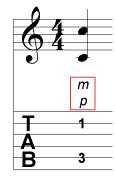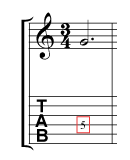Element: technical
Description
Technical indications give performance information for individual instruments.
Derived By
Type technical
Content Model
Contains elements as defined in the following table.
| Component | Type | Occurs | Default | Description |
|---|---|---|---|---|
 |
0..* |
|
||
| arrow | arrow | 1..1 |

The arrow element represents an arrow used for a musical technical indication. |
|
| bend | bend | 1..1 |

The bend type is used in guitar and tablature. The bend-alter element indicates the number of steps in the bend, similar to the alter element. As with the alter element, numbers like 0.5 can be used to indicate microtones. Negative numbers indicate pre-bends or releases; the pre-bend and release elements are used to distinguish what is intended. A with-bar element indicates that the bend is to be done at the bridge with a whammy or vibrato bar. The content of the element indicates how this should be notated. |
|
| double-tongue | empty-placement | 1..1 |

The double-tongue element represents the double tongue symbol (two dots arranged horizontally). |
|
| down-bow | empty-placement | 1..1 |

The down-bow element represents the symbol that is used both for down-bowing on bowed instruments, and down-stroke on plucked instruments. |
|
| fingering | fingering | 1..1 |

Fingering is typically indicated 1,2,3,4,5. Multiple fingerings may be given, typically to substitute fingerings in the middle of a note. The substitution and alternate values are "no" if the attribute is not present. For guitar and other fretted instruments, the fingering element represents the fretting finger; the pluck element represents the plucking finger. |
|
| fingernails | empty-placement | 1..1 |

The fingernails element is used in notation for harp and other plucked string instruments. |
|
| fret | fret | 1..1 |

The fret element is used with tablature notation and chord diagrams. Fret numbers start with 0 for an open string and 1 for the first fret. |
|
| hammer-on | hammer-on-pull-off | 1..1 |

The hammer-on and pull-off elements are used in guitar and fretted instrument notation. Since a single slur can be marked over many notes, the hammer-on and pull-off elements are separate so the individual pair of notes can be specified. The element content can be used to specify how the hammer-on or pull-off should be notated. An empty element leaves this choice up to the application. |
|
| handbell | handbell | 1..1 |

The handbell element represents notation for various techniques used in handbell and handchime music. |
|
| harmonic | harmonic | 1..1 |

The harmonic type indicates natural and artificial harmonics. Allowing the type of pitch to be specified, combined with controls for appearance/playback differences, allows both the notation and the sound to be represented. Artificial harmonics can add a notated touching-pitch; artificial pinch harmonics will usually not notate a touching pitch. The attributes for the harmonic element refer to the use of the circular harmonic symbol, typically but not always used with natural harmonics. |
|
| heel | heel-toe | 1..1 |

The heel and toe elements are used with organ pedals. The substitution value is "no" if the attribute is not present. |
|
| hole | hole | 1..1 |

The hole type represents the symbols used for woodwind and brass fingerings as well as other notations. |
|
| open-string | empty-placement | 1..1 |

The open-string element represents the zero-shaped open string symbol. |
|
| other-technical | placement-text | 1..1 | The other-technical element is used to define any technical indications not yet in the MusicXML format. This allows extended representation, though without application interoperability. |
|
| pluck | placement-text | 1..1 |

The pluck element is used to specify the plucking fingering on a fretted instrument, where the fingering element refers to the fretting fingering. Typical values are p, i, m, a for pulgar/thumb, indicio/index, medio/middle, and anular/ring fingers. |
|
| pull-off | hammer-on-pull-off | 1..1 |

The hammer-on and pull-off elements are used in guitar and fretted instrument notation. Since a single slur can be marked over many notes, the hammer-on and pull-off elements are separate so the individual pair of notes can be specified. The element content can be used to specify how the hammer-on or pull-off should be notated. An empty element leaves this choice up to the application. |
|
| snap-pizzicato | empty-placement | 1..1 |

The snap-pizzicato element represents the snap pizzicato symbol. This is a circle with a line, where the line comes inside the circle. It is distinct from the thumb-position symbol, where the line does not come inside the circle. |
|
| stopped | empty-placement | 1..1 |

The stopped element represents the stopped symbol, which looks like a plus sign. |
|
| string | string | 1..1 |

Fret and string are used with tablature notation and chord symbols. Fret numbers start with 0 for an open string and 1 for the first fret. String numbers start with 1 for the highest string. The string element can also be used in regular notation. |
|
| tap | placement-text | 1..1 |

The tap element indicates a tap on the fretboard. The element content allows specification of the notation; + and T are common choices. If empty, the display is application-specific. |
|
| thumb-position | empty-placement | 1..1 |

The thumb-position element represents the thumb position symbol. This is a circle with a line, where the line does not come within the circle. It is distinct from the snap pizzicato symbol, where the line comes inside the circle. |
|
| toe | heel-toe | 1..1 |

The heel and toe elements are used with organ pedals. The substitution value is "no" if the attribute is not present. |
|
| triple-tongue | empty-placement | 1..1 |

The triple-tongue element represents the triple tongue symbol (three dots arranged horizontally). |
|
| up-bow | empty-placement | 1..1 |

The up-bow element represents the symbol that is used both for up-bowing on bowed instruments, and up-stroke on plucked instruments. |
|
Referenced By
- Complex Type notations
Example

<note default-x="83">
<pitch>
<step>F</step>
<octave>4</octave>
</pitch>
<duration>4</duration>
<voice>1</voice>
<type>quarter</type>
<stem default-y="0.5">up</stem>
<notations>
<technical>
<up-bow default-x="1" default-y="5" placement="above"/>
</technical>
</notations>
</note>
